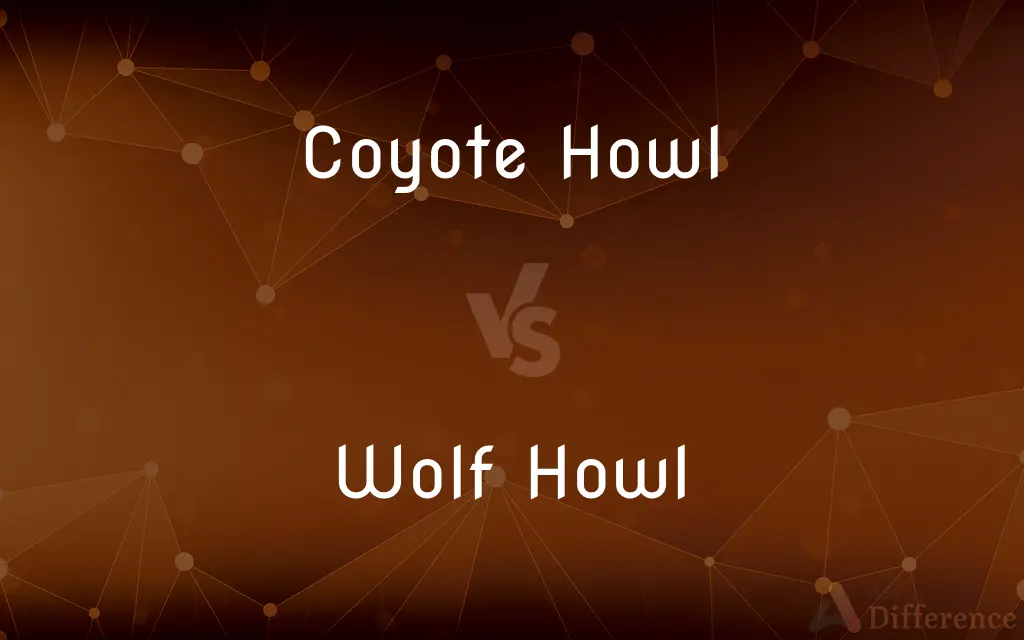Coyote Howl vs. Wolf Howl — What's the Difference?
By Tayyaba Rehman — Published on November 14, 2023
Coyote howls are short, high-pitched, and yippy; they communicate local happenings. Wolf howls are long, deep, and haunting; they signal territory and group unity.

Difference Between Coyote Howl and Wolf Howl
Table of Contents
ADVERTISEMENT
Key Differences
Coyote howls, distinct in their nature, tend to be shorter and higher in pitch. This yippy and sharp sound is often associated with their lively and adaptable nature. Wolf howls, on the other hand, are more profound and elongated, representing the power and majesty of these large canids.
Coyote howls serve various functions including communicating about local happenings or alerting the pack about nearby threats. The Wolf howl, while also a form of communication, is typically used to signal territory boundaries or convey unity within the pack.
One may often hear a series of Coyote howls, usually signifying excitement, a potential threat, or an attempt to regroup. In contrast, the Wolf howl, with its eerie and prolonged sound, can serve as a rallying call or a declaration of their presence in a particular territory.
In urban areas, it's more common to hear the adaptable Coyote howl, given their increasing presence in such environments. The Wolf howl is generally heard in more remote, wild regions, reflecting their preference for vast wilderness and low human interference.
When distinguishing between the two, it's beneficial to note the length and pitch of the sound. A short, yippy, high-pitched cry is indicative of a Coyote howl. In contrast, a long, deep, haunting tone is characteristic of the Wolf howl.
ADVERTISEMENT
Comparison Chart
Pitch
High-pitched
Deep
Duration
Short
Long
Common Purpose
Alert about local happenings
Signal territory and unity
Presence in Areas
Common in urban and adaptable areas
Found in remote, wild regions
Associated Imagery
Lively, alert, and yippy
Powerful, haunting, and majestic
Compare with Definitions
Coyote Howl
A brief, yippy call often heard in series.
The series of Coyote howls seemed to come from different directions.
Wolf Howl
A haunting and majestic call often heard during dusk or dawn.
As the sun dipped below the horizon, the Wolf howl pierced the evening air.
Coyote Howl
An audible sign of the adaptable nature of urban coyotes.
Walking through the park, I heard a Coyote howl, reminding me of nature's presence in the city.
Wolf Howl
An iconic representation of wild, untouched wilderness.
Amidst the serene forest, a lone Wolf howl resonated, capturing the essence of the wild.
Coyote Howl
A sound signaling local events or threats in a coyote pack.
The sudden Coyote howl alerted me to something happening nearby.
Wolf Howl
A vocalization indicating the presence or movement of a wolf pack.
The echoing Wolf howl informed us that the pack was on the move.
Coyote Howl
A vocalization representing the liveliness of coyotes.
The playful Coyote howl echoed across the canyon.
Wolf Howl
A deep and prolonged vocalization made by wolves.
The Wolf howl sent shivers down my spine on the cold winter night.
Coyote Howl
A high-pitched vocalization made by coyotes.
The desert night was punctuated by the distinct Coyote howl.
Wolf Howl
A sound marking territory and expressing pack unity.
The distant Wolf howl told other packs that this territory was claimed.
Common Curiosities
Where might you hear a Wolf howl?
Wolf howls are commonly heard in wild, remote areas, indicating the presence of a wolf pack.
Is the Coyote howl shorter than the Wolf howl?
Yes, Coyote howls are typically shorter and more yippy compared to the prolonged Wolf howl.
What is a Coyote howl?
A Coyote howl is a high-pitched vocalization made by coyotes, often used to communicate within the pack.
How is a Wolf howl different?
A Wolf howl is deeper, longer, and is used primarily for marking territory and expressing pack unity.
Do coyotes howl more frequently in urban areas?
Yes, with their adaptable nature, coyotes often vocalize in urban areas, signaling their presence.
What do wolves signal with their howl?
Wolves signal territory boundaries, pack unity, and other communications with their howl.
How often do wolves howl?
Frequency varies, but they often howl to communicate with pack members, especially during dawn or dusk.
Is the Coyote howl indicative of their adaptable nature?
Absolutely, the Coyote howl, especially in diverse environments, showcases their adaptability.
Is the pitch of a Coyote howl usually higher than that of a Wolf howl?
Yes, Coyote howls tend to be higher-pitched, while Wolf howls are deeper.
Do both coyotes and wolves use their howls to communicate?
Yes, both use howls for communication, but the purposes and nuances might differ.
Is the Coyote howl usually lively and alert?
Yes, the Coyote howl often represents the liveliness and alert nature of coyotes.
Can Coyote howls be mistaken for Wolf howls?
While they can be confused, paying attention to pitch and duration can help distinguish between the two.
Are Wolf howls often linked with the imagery of the wilderness?
Yes, the haunting Wolf howl is iconic in representing wild, untouched areas.
Do both Coyote howls and Wolf howls play a role in their social structures?
Yes, both howls serve vital roles in communication, territory marking, and maintaining social order within their packs.
Can a Wolf howl be a rallying call?
Yes, wolves can use their howls as rallying calls for the pack.
Share Your Discovery

Previous Comparison
Minerals vs. Rocks
Next Comparison
Taiwanese Food vs. Chinese FoodAuthor Spotlight
Written by
Tayyaba RehmanTayyaba Rehman is a distinguished writer, currently serving as a primary contributor to askdifference.com. As a researcher in semantics and etymology, Tayyaba's passion for the complexity of languages and their distinctions has found a perfect home on the platform. Tayyaba delves into the intricacies of language, distinguishing between commonly confused words and phrases, thereby providing clarity for readers worldwide.
















































